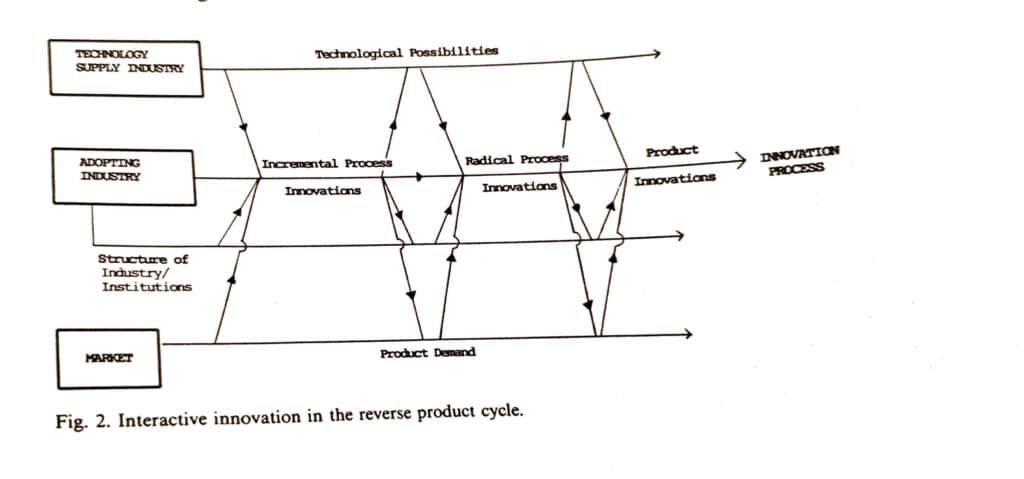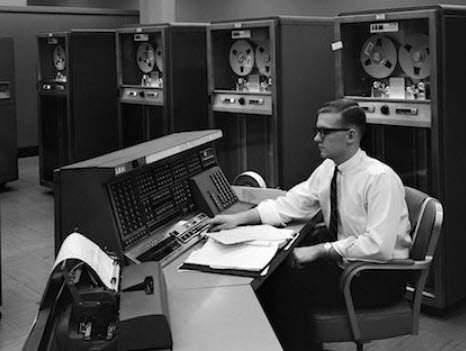Looking at the ways GenAI is being adopted and deployed across a range of industries has parallels with academic research from the late 1980s into innovation within service sector firms. Building on earlier work by Abernathy and Utterback [1]Abernathy, W.J. and Utterback, J.M., 1978. Patterns of industrial innovation. Technology review, 80(7), pp.40-47. on the dynamics of innovation in the manufacturing sector, Richard Barras adapted their work to the service sector.
From Product to Process Innovation
Abernathy and Utterback pointed out that innovation on new product categories within manufacturing firms tended to follow a common pattern: the initial focus of activity was in innovating around product configurations until a dominant design was arrived at. When that occurred, innovative activities moved to process-oriented innovations and ways to mass produce the new products at scale and at low cost. The automobile industry is a good example where the first 20 years of activity saw a range of designs and power trains from electric, steam and the internal combustion engine. By the 1920s, the dominant design of 4 wheels, a steering wheel and the ICE was settled on and manufacturers then focused on mass production. The winners here were Ford and GM that invented and then iterated on the assembly line as the most efficient way to produce cars by the millions to meet the increasing demand.
Service Sector Innovation is the Reverse
Barras [2]Barras, R., 1990. Interactive innovation in financial and business services: The vanguard of the service revolution. Research policy, 19(3), pp.215-237. saw a reverse pattern happening in the ways that service sector firms such as banks and insurers were adopting computing technologies from the 1960s to the 80s. Their initial focus was on applying ICTs to back-office functions such as accounting and payroll. Once these processes were established then the focus shifted to changing service offerings to customers including ATMs and interactive services such as early forms of home banking. Underpinning these processes is the interaction between technology suppliers, market dynamics and adopters. These impacted each other dynamically through a process of adoption and feedback to suppliers and the broader market:
“Thus the major financial institutions were only able to invest heavily in the technological opportunities presented by mainframe computers because their capital base gave them the capacity to do so; having built up their expertise with the first generation of the technology, which allowed them to improve their operating efficiency and serve the new international markets opened up by liberalisation and deregulation” (Barras 1990, page 224)

GenAI Adoption and Interactive Innovation
A similar pattern is emerging with the adoption of GenAI technologies within enterprises. Their potential to transform and streamline many internal business processes is significant and the focus of many early investments and experiments. Manipulating, analysing and repurposing data at scale and high speed is an obvious first step for many larger businesses. As these deployments are embedded in workflows, the focus will shift to more customer-facing activities. We are starting to see this with more automated customer services but the eventual rise of genuine agentic AI services will be step change over the coming years and transform how many businesses interact with customers and suppliers. Equally, vendors and developers and learn valuable lessons from these deployments and adapt their offerings accordingly.
Matt Marshall at VentureBeat recently reported on the ways that enterprises are adapting small open source LLMs to process and extract value from internal data sets using techniques such as retrieval augmented generation (RAG). As this process continues and evolves, developers will iterate on model development in an interactive way with users. Many of these developments will take place behind closed doors. As Matt says, “Many companies just don’t want to talk publicly about what they’re doing with open-source LLMs… an explosion of open-source LLMs geared for the enterprise has emerged from startups in recent months.”
The reverse product cycle lives on.
References
Abernathy, W.J. and Utterback, J.M., 1978. Patterns of industrial innovation. Technology review, 80(7), pp.40-47.
Barras, R., 1990. Interactive innovation in financial and business services: The vanguard of the service revolution. Research policy, 19(3), pp.215-237.


